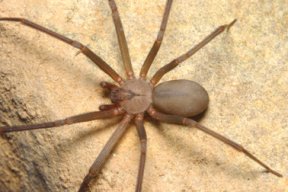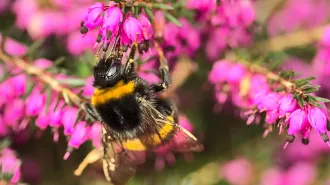Despite the general image of spiders as avid hunters, brown recluses in recent laboratory tests typically preferred dead prey to live ones. Other species of spiders have been known to scavenge now and then, but the brown recluse may be the first one revealed as primarily a scavenger, says the researcher who performed the experiment.

People generally try to avoid brown recluse spiders because their bites fester into painful sores. Roughly the size of a quarter, these spiders thrive in the south-central United States. When arachnologist Jamel Sandidge of the University of Kansas in Lawrence puts traps in a house, he may collect as many as 1,400 brown recluses in 2 months.
Sandidge began his recent work after hearing that some exterminators urge people to starve the brown recluse spiders by killing all the insects in their homes. He found the advice suspect because, in his visits to dozens of Kansas houses, he’d seen the spiders feeding on insects that had been dead for weeks.
In his laboratory, Sandidge tested 147 adult brown recluses, putting each into an enclosure with a live insect and a carcass of the same species and size. After 5 minutes, Sandidge checked to see which insect the spider had been feeding on. The spiders went for the dead prey more than 80 percent of the time, whether they were dining on crickets, which are larger than brown recluse spiders; yellow mealworm larvae, which are similar to the spider in size; or wax moth larvae, which are smaller, Sandidge reports in the Nov. 6 Nature.
He’s seen the spiders run away from the live crickets.
In other tests, Sandidge found that the spiders were willing to feed on month-old carcasses of cockroaches, as well as crickets that had been dead for 2 weeks. He also reports that 10 spiders showed no ill effects during the 10 months after eating a cockroach that had been killed with a common pyrethrin insecticide.
Another investigator of spiders, Simon Pollard of the Canterbury Museum in Christchurch, New Zealand, is studying spiders that ingest blood by catching well-fed mosquitoes. He comments, “While it is not that unusual for spiders to eat inanimate things, like pollen, nectar, or prey remains, it is unusual for a spider to seem to prefer dead prey over live prey.”
However, he can imagine advantages to a spider that eats carcasses. “A disgusting thought,” he explains, “but spiders externally digest their prey and suck up the dissolved nutrients. If the prey is starting to break down into a liquid form, it may require less digestive fluid.”
****************
If you have a comment on this article that you would like considered for publication in Science News, send it to editors@sciencenews.org. Please include your name and location.






